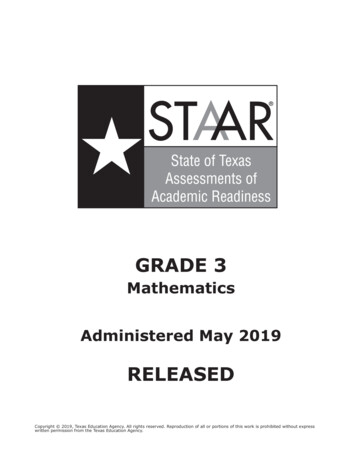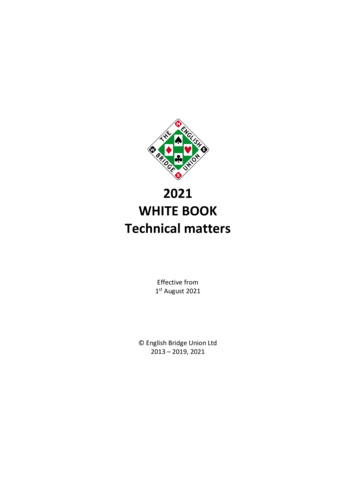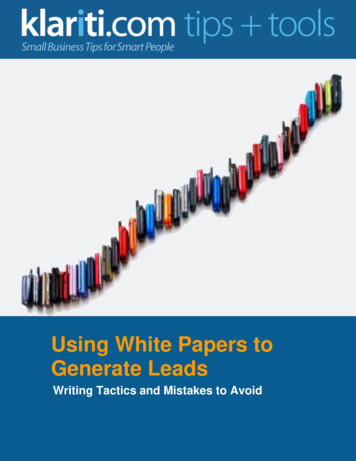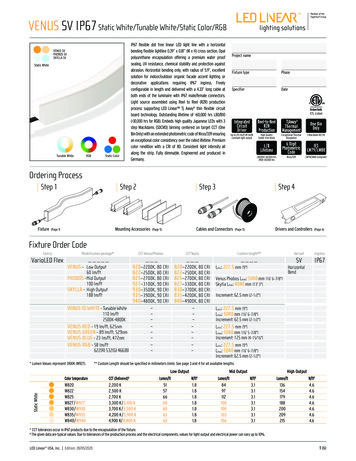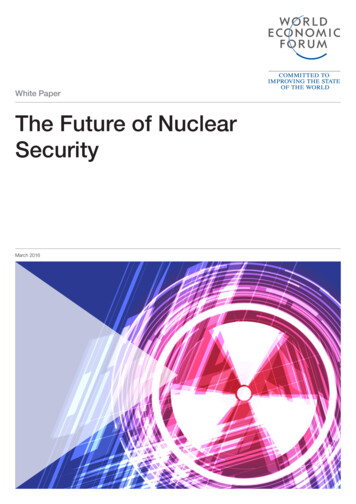
Transcription
White PaperThe Future of NuclearSecurityMarch 2016
WORLD ECONOMIC FORUM, 2016 – All rights reserved.No part of this publication may be reproduced ortransmitted in any form or by any means, includingphotocopying and recording, or by any informationstorage and retrieval system.REF 010316
World Economic Forum White PaperThe Future of Nuclear SecurityMarch 2016The views expressed in this White Paper are those of the author(s) and do not necessarily represent the viewsof the World Economic Forum or its Members and Partners. White Papers are submitted to the WorldEconomic Forum as contributions to its insight areas and interactions, and the Forum makes the final decisionon the publication of the White Paper. White Papers describe research in progress by the author(s) and arepublished to elicit comments and further debate.1
ContentsBackgroundandOverview . 3AbouttheScenarios . .3ExecutiveSummary .4GeopoliticsGoneAwry . .6KeyInsights 7TechnologyGoneAwry 11KeyInsights 11NuclearSecurityandNon- ‐StateActors . 13KeyInsights 142
Background and Overview“One thing a person cannot do, no matter how rigorous his analysis or heroic his imagination, is todraw up a list of things that would never occur to him.”– Thomas Schelling, Nobel LaureateThe Nuclear Futures exercise uses scenario-planning methodologies to challenge the assumptionprevailing during much of the last quarter century that the threat posed by nuclear weapons is interminal decline. By creating and assessing plausible and provocative scenarios (that are in somecases likely), a working group from the World Economic Forum's Global Agenda Council onNuclear Security hope to raise awareness of the breadth, urgency, complexity and potentialdeleterious consequences of the multidimensional nuclear security challenges facing political andmilitary leaders throughout the world.To advance the council's work, the working group (this White Paper's authors and councilmembers Graham Allison, Leon Fuerth and Tate Nurkin) called upon experts for input. A workshopwas hosted in Washington DC with cybersecurity experts to help the council articulate the role thatemerging technology and cybersecurity threats play in shaping the future nuclear securityenvironment. Engagement with multiple and multidisciplinary experts ensures that the analysisincorporates a sufficiently diverse range of perspectives on this critical, often emotionally tingedand urgent issue.About the ScenariosEach of the exercise's three phases was designed to isolate a particularly powerful driver ofnuclear risk (outlined in the Figure). Each phase also includes a different approach to scenariowriting and analysis: specific scenario pathways are articulated in the Geopolitics Gone Awrysection, while more general summaries are used in the other two sections. None of the scenariosdeveloped in this exercise was designed to be predictive. The council does not suggest that thesefutures are inevitable. However, they are based on real-world processes that are either ongoing,expected in the near future or, even if less likely, plausible. They are designed to question currentassumptions about nuclear security and to highlight policy or actions of important actors that couldincrease the risk of a nuclear crisis. These scenarios are best viewed as objective and innovativedevices to get beyond current analytical filters, challenge existing assumptions and expandthinking about current and future challenges.Figure: Three Phases of Nuclear Risk DriversPhase One: Geopolitics GoneAwryPhase Two: Technology GoneAwryPhase Three: Nuclear Securityand Non-State Actors Development and considerationof scenarios to better identify andassess how geopoliticalcompetition can driveunintentional escalation,miscalculation and, ultimately,crises with a nuclear dimension.These scenarios will also explorehow geopolitical drivers canchallenge the non-proliferationregime. Development and considerationof scenarios to better identify andassess how the introduction,evolution and application ofcommercial and dual-usetechnologies can pose threats tonuclear security. These scenariosalso explore how thedevelopment and proliferation ofadvanced military capabilities cangenerate escalation, incentivesfor preemption and, ultimately,nuclear crisis. Development and considerationof two categories of non-statearmed groups acquiring nuclearweapons or radiological material.This category of analysis includesexamination of non-state armedgroup motivation and capacity toacquire these weapons.3
Executive SummaryThis White Paper has identified five key themes, scenario elements and insights that are relevantacross multiple scenario groups:1. Intersecting (not independent) drivers: Geopolitics, technology, non-state actors and newmindsets about nuclear risk and use should be viewed as intersecting, rather thanindependent, drivers of deteriorating nuclear security.2. Rapidly increasing complexity and velocity: Intensifying geopolitical competition, as well asthe introduction and availability of new military and commercial technologies to state and nonstate actors, are increasing the complexity of nuclear crises and the pace at which they unfold.Two challenges emerge as the time available to discuss and respond to fast-moving nuclearcrises dwindles ever closer to zero. First, the ability of people to accurately discern andappropriately respond to nuclear crises will be diminished. Second, and as a result, humansmay enhance their reliance on technical solutions, including artificial intelligence, to digestrelevant information quickly. Combined, these two challenges will make it difficult to stopnuclear response protocols once they begin, and will create an environment in whichmiscalculation, accidental escalation and even pre-emption become more likely.3. New catalysts for nuclear crisis: This fast-moving and complex environment will producenew triggers of crises and conflict that could escalate to nuclear confrontation – most notablyclimate change, but also cyberconflict and cascading proxy conflicts between nuclear-armedgeopolitical competitors.4. Human factors, artificial intelligence and nuclear security: Recent high-profile scandalsrelated to the security of the United States’ nuclear arsenal have generated growing concernabout the effective implementation and monitoring of training protocols across organizationsresponsible for nuclear security in all nuclear-armed states. Moreover, insider threats wereseen as a growing challenge to information technology and physical infrastructures relevant tonuclear security. Insider threats were also assessed to be an increasingly plausible mechanismfor proliferating nuclear and radiological materials and know-how to non-state groups by lonewolves and insiders that share an ideological sympathy with these groups.5. New actors and new thinking about nuclear weapons requiring new solutions: Newmentalities and capabilities will require adjustments to long-held concepts of deterrence anddissuasion. Military planners will need to reconsider questions about the sufficiency of anarsenal's size and disarmament in order to establish and maintain nuclear stability in thisenvironment.In addition, discussion during the exercise covered several components of a broader approach torisk mitigation: Transparency: The need for enhanced transparency on the size of arsenals, nuclear doctrineand concepts of operations of advanced and destabilizing capabilities, such as hypersonics,was repeatedly stressed, as was increased intelligence sharing during nuclear crises. This isprimarily because actions can be seen as predictable.Training and education: Analysis stressed increased emphasis on educating generalpopulations about the severity of nuclear insecurity, especially to a younger generation that hasno active memory of the Cold War risks of nuclear conflict.4
Technical solutions: Development of technical solutions to help slow down crises andincrease transparency were seen as critical to mitigating risks associated with a deterioratingnuclear security environment.Intelligence: Horizon scanning analysis, including scenario planning, were seen as valuabletools for increasing the detection horizon for a nuclear-related crisis. They can generate robustsignposts that a nuclear crisis is likely to occur.5
Geopolitics Gone Awry"Great power competition has returned.”– Robert Work, US Deputy Secretary of Defense, in November 2015The working group developed three scenarios related to the Geopolitics Gone Awry phase. Eachscenario abstract included in this section should be considered as a discrete challenge. Dynamicsunfolding in one scenario are not necessarily relevant for the others. The scenario time frames areintentionally ambiguous in order to convey both the urgency and durability of the highlightednuclear security challenges. Those include reckless escalation, miscalculation and failinggeopolitical and security frameworks resulting from, in short, geopolitics gone awry. All thescenarios could occur in the next 6 to 24 months, and all are shaped by underlying competitivedynamics that could play out over a longer time horizon of several years.North Atlantic Treaty Organization/Russia scenarios: The most frequently discussed scenariosleading to a nuclear crisis focused on those in which Russia is assumed to provide support forarmed Russian separatist movements in member states of the North Atlantic Treaty Organization(NATO).Conflict in the Baltic States was viewed as a particularly daunting and revealing path of escalation.The former Soviet republics of Estonia, Latvia and Lithuania have become particularly nervousbecause of Russia’s annexation of Crimea, increased Russian surveillance flights over the BalticSea and the continuing conflict in Ukraine. Underscoring this critical situation is the Baltic States'geographic proximity to Russia, the Russian exclave of Kaliningrad and the large Russianpopulations residing in each of these states.Initially, Russian nationalists protest in the Baltic States, at first and most intensely in Estonia,against the increased NATO presence in their skies. These protests lead to violence between statesecurity forces and Russian protestors that quickly turn into armed separatist conflict. The ensuing,escalating spirals of inflammatory rhetoric; duelling statements of support by the United States andNATO (for its Baltic Allies) and by Russia (in defence of the right of self-determination of Russianseparatists); and mobilization of military and security assets by both sides lead to a standoff – apause before what appears to be an inevitable conflict between NATO and Russia. Baltic alliesrequest assistance from NATO, under the North Atlantic Treaty's Article 5, to combat the growingchallenges to sovereignty stemming from separatist conflict and to deter the possibility of directRussian action. The United States puts its tactical nuclear forces in Europe on high alert, explicitlyintroducing a nuclear dimension to this escalating crisis. Russia has little choice but to heighten itsnuclear readiness in response.Western Pacific crisis: This scenario describes a pathway to nuclear crises through escalatingmilitary confrontations and conflicts over the contested borders and boundaries in the WesternPacific. It explores a specific path to conflict, first between Japan and China over control ofmaritime boundaries in the East China Sea, and then of the United States being quickly drawn intodirect armed conflict with China as part of its treaty obligations to Japan.The escalation of the conflict evolves in line with currently understood US and Chinese strategiesand concepts of operation for prosecuting an anti-access/area denial versus power projectionconflict in East Asia. Elements of the US 7th Fleet are driven back by China’s DF-21D anti-shipballistic missiles, successfully deployed among other anti-ship weapons launched from platformson land, sea and air. The United States targets China’s mainland military assets as part of the Air6
Sea Battle strategy, which was renamed in January 2015 as the Joint Concept for Access andManeuver in the Global Commons. Strikes against China’s homeland lead to the threatened oractual detonation of a nuclear device over a remote portion of the Pacific Ocean, designed todissuade further military strikes against assets in Chinese territory.Cascading proliferation: In this scenario, the number of actual, virtual, imminent or aspirationalnuclear powers, especially in the Middle East/North Africa and East Asia, increases significantlyand rapidly. An Iranian nuclear deal is the main trigger, considered as "too big to fail" particularlyby the P5 1 states (China, France, Russia, the United Kingdom, the United States plus Germany).It also raises concerns among regional actors that this will enable Iran to join a small club of"latent" nuclear powers possessing the technological sophistication to develop nuclear weaponsquickly. A simultaneous proliferation-related crisis on the Korean Peninsula creates a parallel levelof unease in East Asia.These crises combine with a series of events that starkly demonstrate the US inability to arrestboth the deterioration of the security environment across the Middle East and the escalation ofmaritime border and boundary disputes in the Western Pacific. This leads to eroding confidence inUS security guarantees and "nuclear umbrellas" among allies in both regions. Transparency isreduced in an increasingly unsettled environment by more available advanced military capabilities,such as long-range, precision-strike missiles and associated command and control infrastructure,as well as advanced computation, modelling and simulation that may eliminate the need fortraditional testing.This scenario's effects cascade metaphorically and literally beyond buttresses that haveconstrained proliferation in the past. Various types of proliferation – actual, virtual and partial –occur rapidly in this scenario, leading to at least four new "nuclear actors" pursuing proliferation indifferent ways and at different paces, with varying degrees of transparency. Such an environmentinvites a new and destabilizing calculus of deterrence and dissuasion. This scenario ends with thegrowing possibility of pre-emptive intervention in the Middle East to stop suspected nuclearproliferation.Key Insights1. Escalation, miscalculation and a world in transition: All scenarios highlight the growingpotential for spiralling and frequently unintended escalation and miscalculation that arise fromthe intersection of two prevailing trends.First, the predominant geopolitical and security frameworks of the post-Cold War period arebeing challenged and revised. These include treaties governing proliferation of nuclearweapons-related materials, delivery systems and doctrines eschewing first use. Intense,overlapping and complex competition between regional actors marks the current geopoliticalcontext; those actors frequently possess more and better capabilities, and more actors eitherpossess or pursue nuclear weapons to some degree. These actors may have novel mindsetsabout nuclear weapons and the development of strategic systems that are materially differentfrom the primarily bilateral concepts prevailing during the Cold War.The current geopolitical context also includes global powers entangled in geostrategiccompetition that is playing out in multiple regions simultaneously, increasing the number ofalternative geographies and pathways for escalation. When pressure is applied to onegeographic area of heightened geopolitical tensions, the potential for crises and conflict to7
radiate out from the initial point of concern also increases. For example, the working groupconsidered NATO/Russia escalation scenarios playing out in the Arctic, Middle East and partsof Eastern Europe (other than the Baltic States), where NATO’s membership either overlapswith or borders Russia’s conception of its near abroad.Second, military modernization programmes can create destabilizing vulnerabilities andcompetition among nations over their technological prowess. Such programmes do this byprioritizing the development of systems designed to deliver very fast and low observableprecision strikes at long distances (e.g. hypersonic weapons); moreover, they shorten crisisdecision-making timelines and undermine nuclear stability. Efforts to develop advancedtechnologies designed to enhance "traditional" nuclear structures, such as India’s ongoingtesting of the Agni V canisterized missile, will also destabilize nuclear security and stability. Inaddition, emerging technologies (in many cases commercially available and foreseen toproliferate) are designed to challenge the effectiveness of networks and critical communicationnodes (e.g. cyberweapons and electromagnetic spectrum disruption weapons). This willcomplicate, restrict and/or accelerate command and control in a time of crisis. While therelationship between many of these technologies and nuclear security will be explored in moredepth in the second phase of the Nuclear Futures exercise, military modernization andproliferation of advanced capabilities were significant factors in driving escalatory dynamics ineach scenario. Factors also included still-evolving or untested concepts in using these newcapabilities, demonstrating the interconnectedness of the scenario categories investigated.2. Climate change as a trigger for nuclear crises: In this complex and competitive context, newtriggers of crisis and conflict will emerge that could escalate to nuclear confrontation. Themagnitude of disruption associated particularly with climate change, local environmentaldegradation and related resource pressures (water, food and energy) will play a moreprominent role in driving new theatres of competition, as well as enhancing strategic andexistential vulnerabilities for nuclear-armed states. For example, three of them (China, Indiaand Pakistan) are critically dependent on water flowing from the Himalayan glaciers. Anyunilateral action to alter the existing balance of distribution could lead to confrontation; this, inturn, could set off a sequence of escalatory interactions that could overwhelm decision-makers'inhibitions and introduce nuclear weapons into a rapidly evolving regional crisis. Similarly,competition between nuclear-armed actors could increase in the Arctic, as warming conditionsand receding ice enable more shipping traffic through, extraction of natural resources in andmilitary operations across the region.3. Constraints on escalation: The working group determined that opportunities to constrainescalation are already in place in some contexts, especially in the Western Pacific, where theUS and China have developed more extensive military-to-military exchanges. Those can bebuilt upon to limit and slow down, if not fully prevent, the escalation of a crisis. Currently, thesetools may be insufficient to dampen trigger events that, after multiple rapid escalation cycles,could lead to a nuclear security crisis. They can serve, however, as a sound platform forbuilding mechanisms to constrain and limit escalation and miscalculation.In contexts where these tools do not exist, as in the current taut and confrontationalrelationship between the United States and Russia, building measures for increasingtransparency and elongating decision-making timelines during a crisis are urgently needed,even when geopolitical relationships are deteriorating. Developing and using these measuresmust involve government-to-government engagement, as well as private and informal dialogue8
between non-governmental experts. Engagement and dialogue inject creative thinking into theprocess through mutually agreed analyses of critical issues and alternatives for intervention.4. Rethinking nuclear use: The scenarios demonstrated that nuclear “use” should be consideredmore broadly than just the detonation of a strategic nuclear weapon against a population centreor critical infrastructure. Concepts of “use” should also include actors leveraging actual, virtualor aspirational nuclear arsenals for coercive geopolitical, political or economic advantage in ahighly competitive geopolitical environment. The detonation of a small nuclear weapon in theWestern Pacific scenario provides a stark example of the destructive power these weaponshave, even without proximate loss of life. Concepts of nuclear “use” could also expand toinclude the development or employment of tactical nuclear weapons as a deterrent and acapability to wage war, especially against hardened targets increasingly inured to the effects ofconventional “bunker-busting” weapons.The taboos and constraints on proliferation, including formal treaty constraints, will degradewithout effective strengthening and recalibration of current nuclear security regimes, amplifyingconcerns about nuclear security, stability and proliferation.5. Deterrence and dissuasion: Long-held concepts of deterrence and dissuasion must berevisited to account for this new and complicated environment, as in, how are arsenal sizescalculated that are sufficient to deter multiple actors with different interests? And, what deliveryand deterrence systems are required to establish and maintain nuclear stability? Thisenvironment will also demand increased transparency, especially on the security of nuclearweapons materials and safeguards among all nuclear powers, to ensure state control ofweapons in an environment with more proliferation.6. Transparency: The future nuclear security environment is also likely to be more opaque inthree key areas: The actors that actually possess nuclear weapons capabilities or could develop thesecapabilities rapidly The nature and level of sophistication in the capabilities of specific actors, includinguncertainty around arsenal sizes, robustness of command and control practices,safeguarding procedures and the available delivery systems The shifts in formal military doctrine on nuclear use in both old and new nuclear powersLack of transparency in a changing landscape can lead to destabilizing assumptions andbehaviours, especially in a world marked by nuclear proliferation. This could underminedeterrence and drive crisis and conflict rather than deter it.7. Pre-emption and first use: Each of alternative futures introduced incentives for “first use” ofnuclear weapons and/or conventional military pre-emption that target nuclear weapons ornuclear weapons development programmes. Particularly powerful drivers of pre-emption arenuclear delivery systems at high states of alert, as in the NATO/Russia scenarios, or the needto dissuade additional conventional conflict and strikes against the homeland of a nuclearpower, as in the Western Pacific scenario. The cascading proliferation scenario presents twotypes of opportunities for nuclear-related pre-emption crises. In one, several new states withsmall nuclear arsenals lacking redundancy and resilience may incentivize first use. In the other,multi-actor, multi-speed and opaque proliferation of nuclear weapons would almost certainlyinvite escalatory rhetoric and behaviours, and possibly conventional or nuclear pre-emption.9
Among the scenarios discussed but not featured in this White Paper was a Caroline Casescenario, which invokes the name of a security crisis in North America between the UnitedStates and Great Britain in 1837. Guidelines established as a result of the crisis became thefoundations for international law on pre-emptive self-defence. In 1842, US Secretary of StateDaniel Webster wrote in a letter to British Foreign Secretary Lord Ashburton that pre-emptiveself-defence must be "instant, overwhelming, leaving no choice of means, and no moment ofdeliberation" for it to be justifiable.This criterion is increasingly relevant and of concern as shifts in attitudes about the proliferationand use of nuclear weapons intersect with the rapidly diminishing time for responding to crises.States may be increasingly at risk of invoking this justification for pre-emptive self-defence, asdecision-makers make the rational if hasty determination that fast-moving geopolitical crisesand seemingly existential threats are "instant" and "overwhelming", and provide "no moment ofdeliberation".10
Technology Gone Awry“Space science, like nuclear science and all technology, has no conscience of its own.”– John F. Kennedy, President of the United States (1961-1963), in a speech given at RiceUniversity, 1962Through internal discussions and a one-day workshop held in Washington DC with members of theGlobal Agenda Councils on Nuclear Security and Cybersecurity, as well as the Meta-Council onEmerging Technology, the working group identified three distinct categories of nuclear securityscenarios related to the Technology Gone Awry phase: Spoofing/cyber: In this scenario, a cyberattack from either a state or non-state actor is used to"spoof" a nuclear-armed state into believing that a (fictitious) nuclear strike has been launchedagainst it. In the targeted state, all networked systems indicate that an attack has beenlaunched, leading to the triggering of response protocols that, barring external intervention, willlead to a "retaliatory" strike. Sabotage: The use of cybertechnologies, robotics and electromagnetic pulse or otheremerging technologies (or combinations of these technologies) to create physical damage tonuclear reactors or, especially, storage facilities, was considered a plausible scenario. Forexample, the cyberhijacking of a commercial airliner (a scenario laid out in a US GeneralAccountability Office report in April 2015) and crashing of that airliner into a spent nuclear fuelpool would create a significant radiological effect. Similarly, participants explored scenarios thatinvolved targeting spent fuel pools with difficult-to-detect and commercially available dronesarmed with explosives, or swarms of drones capable of overwhelming air and ground defences.Another sabotage scenario discussed was large-scale cyberattacks against non-nuclear criticalinfrastructure that could lead to a nuclear response. Speeding up: The development of advanced military technologies designed to deliver kineticforce from long distances and at great speeds – e.g. hypersonic weapons that travel betweenMach 5 and Mach 10, or 5 to 10 times the speed of sound – could greatly destabilize nuclearsecurity if concepts of operations and doctrines of use are not clearly stated and madetransparent. Launching these missiles against a nuclear power would further reduce the timeframes for determining the nature of the incoming threat (nuclear or conventional) and decidingon an appropriate response.Key Insights1. Velocity, complexity and crisis stability: Emerging technologies – those commerciallyavailable or for advanced military use – are amplifying threats to nuclear and geopolitical crisisstability by increasing the complexity of highly sensitive systems designed to avoid, slow downor de-escalate nuclear crises and the speed at which they unfold. The combination oftechnology-driven complexity and velocity is overwhelming human cognition and the ability tocontrol these systems. This is especially the case given deficiencies in training and complacentmindsets among nuclear operators, as documented in the United States and elsewhere.2. The expanding threat spectrum and the asymmetric curve: Many emerging technologies,such as cybertechnologies and cyber know-how, are increasingly commercially available oravailable to non-state actors, and provide a highly asymmetric means of exploiting nationstates' vulnerabilities. The cost of developing technologies and practices to defend against a11
cyberattack, for instance, far outweighs the cost of designing and executing such an attack. Inaddition, the current competitive dynamics of the global defence trade ensure that advancedmilitary technologies are being transferred to emerging export markets. More actors can affectstrategic and operational environments throughout the world because of the democratization oftheir ability and capabilities up and down the growing threat spectrum – from ideologicallyinspired and technologically savvy individuals all the way to modern nation states. In manycases, this allows the creative deployment of emerging technologies, enabling actors to affectthese environments with limited financial or logistical burden.3. Lone wolves and new mindsets: Lone-wolf actors, small motivated groups, transnationalnetworks or insider threats were seen as the most likely source of the first two categories ofthreat-spoofing and sabotage. These actors would be motivated by the following mindsets (byone or a combination of them) that would legitimize cyberattacks targeting very secure nuclearsystems to start a nuclear conflict or generate a nuclear/radiological disaster: Nihilism Extremist ideological or religious dogma that stresses the battle between good and evil, and"end of days" narratives "Black hat" mentalities that venerate those capable of hacking the most secure systems,especially among a generation of young hackers that are at least a generation removedfrom the existential nuclear risks and fears of the Cold War periodParticipants also noted the changed and changing mindsets of political and military leaders aroundthe world that may view these capabilities merely as some of the many tools available to them topursue interests, and therefore as weapons that could be used in a cris
4. Human factors, artificial intelligence and nuclear security: Recent high-profile scandals related to the security of the United States' nuclear arsenal have generated growing concern about the effective implementation and monitoring of training protocols across organizations responsible for nuclear security in all nuclear-armed states.





